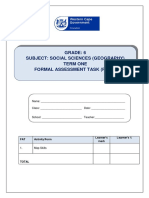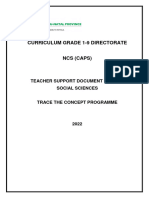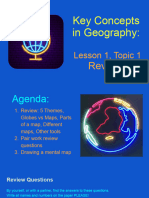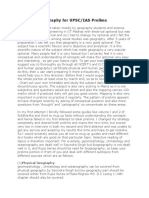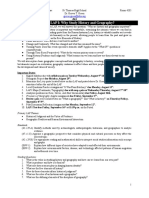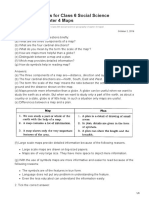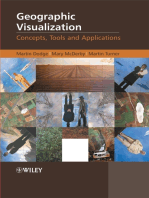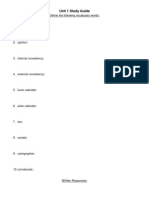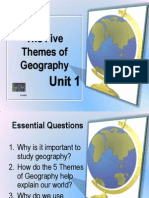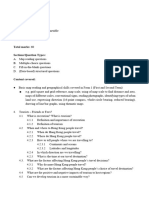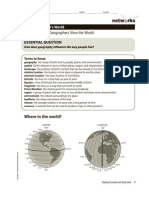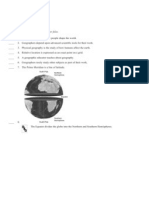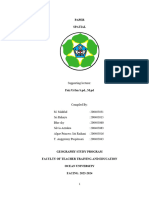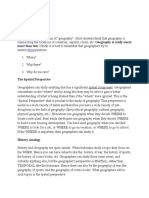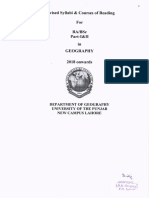AP Human Geography Final Exam Study Guide
AP Human Geography Final Exam Study Guide
Uploaded by
api-457131612Copyright:
Available Formats
AP Human Geography Final Exam Study Guide
AP Human Geography Final Exam Study Guide
Uploaded by
api-457131612Original Title
Copyright
Available Formats
Share this document
Did you find this document useful?
Is this content inappropriate?
Copyright:
Available Formats
AP Human Geography Final Exam Study Guide
AP Human Geography Final Exam Study Guide
Uploaded by
api-457131612Copyright:
Available Formats
AP Human Geography Final Exam Study Guide Name:
Period:
Due: QUIZ GRADE:
Directions: Use the following questions to help you prepare for the upcoming SPG/ Final Exam and AP Exam.
1. What two questions do geographers ask?
2. Give a definition for geography in your own words.
3. What are the two major branches of geography?
4. What are the two main features of “human geography”?
5. What is the most important tool of geographers?
6. Why is every “place” so unique?
7. Give an example of “Scale” relating to Globalization.
8. Why are geographers so interested in ‘Connections”?
9. Define a “Region” and give 2 examples of them.
10. What do “Cartographers” do?
11. Name 2 purposes a map.
12. Name one contribution each of the following people made to geography.
a. Aristotle
b. Thales
c. Eratosthenes
d. Ptolemy
e. Phei Hsiu
f. Ibn-Battutah
g. Mercator
13. What is a “fractional scale”?
14. What is a “Projection” in geographical terms?
15. Name 4 problems with distortion when we try to represent the earth on a flat surface.
16. What are the problems with distortion when using a :
a. Robinson Projection-
b. Mercator Projection-
17. Why was the Land Ordinance of 1785 so significant?
18. What is a “Township”?
19. What is a “Range”?
20. Is the Township and Range System found anywhere today? Where?
21. What is “GIS”?
22. How does GIS work and who uses it and why is it so valuable?
23. What is “Remote Sensing” and how does it work?
24. What is a “Topographic Map” and how is it used?
25. What is GPS and who uses it?
26. How can GPS be so precise?
27. What is a “Toponym”?
28. What are some of the factors taken in when naming places?
29. What are some of the reasons names of places are changed?
30. What is the difference between “Site” and “Situation”/
31. Give 3 examples of Site factors.
32. Give 3 examples of Situation factors.
33. What is meant by “Mathematical Location”?
34. Where is the “Prime Meridian”?
35. How is “Longitude” determined?
36. Where is the “International Date Line”?
37. When it is 2:00 PM in Naples on January 30th what time and date is it in Sydney, Australia?
38. What is meant by a “Sense of Place”?
39. Who really creates regions?
40. Define a “Formal Region” and give 3 examples NOT in the book.
41. Define a “Functional Region” and give 3 examples NOT in the book.
42. Define a “Vernacular Region” and give 3 examples NOT in the book.
43. How do physical features of a region influence human activities?
44. Why do human geographers need to be familiar with “Climatology”?
45. What is “Geomorphology”?
46. What is meant by “Scale: From Local to Global”?
47. How has Kant compared geography to history?
48. What is the difference between “Distribution” and “Density”?
49. What is the difference between “Density” and “Concentration”?
50. Name the 3 properties of distribution.
51. What is meant by “Space-Time Compression” and give 2 examples?
You might also like
- Miller GAS STRAND Thesis CompilationDocument17 pagesMiller GAS STRAND Thesis CompilationMaestro Mertz100% (4)
- Gender Pay Gap EssayDocument15 pagesGender Pay Gap Essayapi-437559828No ratings yet
- GR 6 SS FATs Term 1 Geography FinalDocument10 pagesGR 6 SS FATs Term 1 Geography FinalPrecious NcongwaneNo ratings yet
- The Thames Foreshore: Dates and Permits StructureDocument4 pagesThe Thames Foreshore: Dates and Permits Structurecorinne millsNo ratings yet
- Ultimate Guide To AP World History 2018-2019Document20 pagesUltimate Guide To AP World History 2018-2019Henry Ma50% (6)
- The Color Monster: A Story About Emotions: VocabularyDocument11 pagesThe Color Monster: A Story About Emotions: Vocabularymary100% (1)
- Republic Act No 7610 Child AbuseDocument16 pagesRepublic Act No 7610 Child AbuseJohnde MartinezNo ratings yet
- The Cultural Landscape CH 1 QuestionDocument6 pagesThe Cultural Landscape CH 1 Questionapi-243222812No ratings yet
- BLANKUnit1StudyGuide 230804 115855Document7 pagesBLANKUnit1StudyGuide 230804 115855q9h66ys9dcNo ratings yet
- Study Guide For Chapter 1 Review All Vocabulary For The Unit in Addition To The Questions Below. Themes of GeographyDocument2 pagesStudy Guide For Chapter 1 Review All Vocabulary For The Unit in Addition To The Questions Below. Themes of Geographyapi-327777794100% (1)
- Exam Draft EGEO 423 & 211 & Course OutlineDocument8 pagesExam Draft EGEO 423 & 211 & Course OutlinejacesprintersNo ratings yet
- Geography 7 Skills ANSWERSDocument20 pagesGeography 7 Skills ANSWERSmitsupl12No ratings yet
- Correctedlp2 TwestDocument19 pagesCorrectedlp2 Twestapi-340860586No ratings yet
- Trace The Concept Grade 8 Teacher Guide Document 2 240119 101014Document182 pagesTrace The Concept Grade 8 Teacher Guide Document 2 240119 101014Landiwe LangaNo ratings yet
- G7 Geo T1 L1 Review 2Document25 pagesG7 Geo T1 L1 Review 2rwilliamsonNo ratings yet
- Year 8 Geography Worksheet-1Document4 pagesYear 8 Geography Worksheet-1Roblox Support100% (1)
- Preparing Geography For UPSCDocument3 pagesPreparing Geography For UPSCSaket BharadvajNo ratings yet
- General Knowledge For PrelimnsDocument7 pagesGeneral Knowledge For Prelimnssatya_dinesh205046No ratings yet
- Final Exam: Question 1: Valuable Lessons in GeographyDocument9 pagesFinal Exam: Question 1: Valuable Lessons in GeographyEric ToyNo ratings yet
- Geo Sly - Ba - BSC - 1stDocument4 pagesGeo Sly - Ba - BSC - 1stIrfan AhmedNo ratings yet
- Remote Sensing and GISDocument4 pagesRemote Sensing and GISYalew BizuNo ratings yet
- CartographyDocument12 pagesCartographyavinashkakarlaNo ratings yet
- Demo 30 Objective Indian Geography Abhisekh Dubey OswaalDocument31 pagesDemo 30 Objective Indian Geography Abhisekh Dubey OswaalPunam KumariNo ratings yet
- Sem-III Syllabus CombinedDocument8 pagesSem-III Syllabus Combinedarchismanpaul040No ratings yet
- Advanced Lap I Fall 2022Document8 pagesAdvanced Lap I Fall 2022Evan FilleyNo ratings yet
- Geograghy Grade 10 Critical Thinking Practice QuestionsDocument2 pagesGeograghy Grade 10 Critical Thinking Practice QuestionsRaidioactiveguyNo ratings yet
- Multiple Choice Question Bank (MCQ) Term - I: Class - XIIDocument125 pagesMultiple Choice Question Bank (MCQ) Term - I: Class - XIInikita karwaNo ratings yet
- Review Qs 5 Themes Unit CPDocument2 pagesReview Qs 5 Themes Unit CPapi-271256679No ratings yet
- YR7 HASS Introduction PP WK1 2024Document27 pagesYR7 HASS Introduction PP WK1 2024aden.tj.chiaNo ratings yet
- Unit1test PDFDocument5 pagesUnit1test PDFurgazuNo ratings yet
- Class 6 Social Science Geography Chapter 4 MapsDocument8 pagesClass 6 Social Science Geography Chapter 4 MapsDhahajeed IbnuNo ratings yet
- 01 Geography PO-PSO-CODocument6 pages01 Geography PO-PSO-COsnapexample3030No ratings yet
- Aphug Unit 1 Syllabus sp20Document3 pagesAphug Unit 1 Syllabus sp20api-369449529100% (1)
- Geographic Visualization: Concepts, Tools and ApplicationsFrom EverandGeographic Visualization: Concepts, Tools and ApplicationsRating: 5 out of 5 stars5/5 (1)
- Unit 1 Study GuideDocument4 pagesUnit 1 Study Guideapi-250138713No ratings yet
- Thinking Maps: Tools For Cognitive Development: Kementerian Pendidikan MalaysiaDocument27 pagesThinking Maps: Tools For Cognitive Development: Kementerian Pendidikan MalaysiaEmmot LizawatiNo ratings yet
- 0.0.1. PGTR Kartografi - 2020 - CompressedDocument52 pages0.0.1. PGTR Kartografi - 2020 - Compressedzulfianic.asturNo ratings yet
- b.a. (Geography) Part - i (Semester i & II) Session 2020-21, 2021-22 and 2022-23Document9 pagesb.a. (Geography) Part - i (Semester i & II) Session 2020-21, 2021-22 and 2022-23jahangiralamraj5No ratings yet
- PG GeographyDocument40 pagesPG GeographyirtexafarooqNo ratings yet
- 1st Semester Exam Study Guide - AP 2014Document25 pages1st Semester Exam Study Guide - AP 2014Carson100% (1)
- Chapter 1 Basic Concepts Key Issues AP Human GeographyDocument12 pagesChapter 1 Basic Concepts Key Issues AP Human GeographyAubree HannahNo ratings yet
- The Five Themes of Geography-Class NotesDocument50 pagesThe Five Themes of Geography-Class NotesdawilleyoneNo ratings yet
- 4 62-Revised-Syllabus-F Y B A F Y B SC - In-GeographyDocument8 pages4 62-Revised-Syllabus-F Y B A F Y B SC - In-GeographyParishram MauryaNo ratings yet
- Republic of The Philippines Leyte Normal University Tacloban CityDocument40 pagesRepublic of The Philippines Leyte Normal University Tacloban CitykathNo ratings yet
- Investigation 2: How Do Geoarchaeologists Use Remote Sensing To Interpret Landscapes?Document12 pagesInvestigation 2: How Do Geoarchaeologists Use Remote Sensing To Interpret Landscapes?Ajay VijayNo ratings yet
- Ap Exam Supplement: Specifically Developed For This Year's AP ExamDocument16 pagesAp Exam Supplement: Specifically Developed For This Year's AP ExammanasNo ratings yet
- ExamsyllabusgeogDocument2 pagesExamsyllabusgeogcelinechiu16bNo ratings yet
- Geog Ubd Yr8Document31 pagesGeog Ubd Yr8api-298026161100% (2)
- Key Methods in Geography 3Rd Edition PDF Full Chapter PDFDocument53 pagesKey Methods in Geography 3Rd Edition PDF Full Chapter PDFamaarheang100% (9)
- Assessment Exam Class 7Document2 pagesAssessment Exam Class 7dodafef533No ratings yet
- Geo 2642 2020Document10 pagesGeo 2642 2020Ralivhesa TalifhaniNo ratings yet
- 26Document6 pages26Syed RaoufNo ratings yet
- If You Are A Member, Log in To Remove The Lines Non-Members Need To SubscribeDocument21 pagesIf You Are A Member, Log in To Remove The Lines Non-Members Need To Subscribekattya40No ratings yet
- NEP-GEODocument49 pagesNEP-GEOJagatjyoti DasNo ratings yet
- 1 - How Geographers View The WorldDocument4 pages1 - How Geographers View The WorldWilliam HoltNo ratings yet
- Where can buy Choosing a Map Projection 1st Edition Miljenko Lapaine ebook with cheap priceDocument48 pagesWhere can buy Choosing a Map Projection 1st Edition Miljenko Lapaine ebook with cheap pricefajlafilia19100% (1)
- Chapter 1 Test StudentsDocument8 pagesChapter 1 Test Studentsapi-96048848No ratings yet
- Spatial InggrisDocument15 pagesSpatial InggrisSri RahayuNo ratings yet
- Immediate Download Solution Manual For Physical Geography 11th Edition Petersen Sack Gabler 1305652649 9781305652644 All ChaptersDocument35 pagesImmediate Download Solution Manual For Physical Geography 11th Edition Petersen Sack Gabler 1305652649 9781305652644 All Chapterseesmaaninfas100% (5)
- WRS RN CH 1Document2 pagesWRS RN CH 1hstojak360No ratings yet
- What Is GeographyDocument5 pagesWhat Is Geographylklklklk8908No ratings yet
- Ggr101 First Take Home Test Winter 2012-2Document3 pagesGgr101 First Take Home Test Winter 2012-2Anna Katherina LeonardNo ratings yet
- B.A.gEOGRAPHYDocument11 pagesB.A.gEOGRAPHYMd. Mushafique Nawaz ChishtyNo ratings yet
- 2019 SUBIECT EXAMEN ORAL 4 Kaqsta6vDocument3 pages2019 SUBIECT EXAMEN ORAL 4 Kaqsta6v14 Kursant(in)No ratings yet
- Geography IIDocument5 pagesGeography IIchandni khanNo ratings yet
- Manajemen Proyek Sistem Informasi (Mpsi) Project Management ContextDocument2 pagesManajemen Proyek Sistem Informasi (Mpsi) Project Management ContextAnisah RangkutiNo ratings yet
- HKUST Digital MBA For Global Leaders BrochureDocument3 pagesHKUST Digital MBA For Global Leaders BrochureSylvian Shooi Yang HwaNo ratings yet
- Media As The 4th Pillar of StateDocument3 pagesMedia As The 4th Pillar of StateZubaria FakharNo ratings yet
- Mock MCQ Test: Subject: Entrepreneurship Development (Ed) Paper Code: Ms 207Document12 pagesMock MCQ Test: Subject: Entrepreneurship Development (Ed) Paper Code: Ms 207Ankit RajNo ratings yet
- The State of Spring 2020Document12 pagesThe State of Spring 2020Carlos BenvenutoNo ratings yet
- Dole Ro8 Checks Issued As of October 28, 2019Document134 pagesDole Ro8 Checks Issued As of October 28, 2019Buah Merah Mix OrmocNo ratings yet
- How To Have A Good Stage PresenceDocument15 pagesHow To Have A Good Stage PresenceJ9 Yu100% (1)
- Introduction Program - 2021: Hardik Ramani 1 Sem IT Department V.V.P. Engineering College RajkotDocument13 pagesIntroduction Program - 2021: Hardik Ramani 1 Sem IT Department V.V.P. Engineering College RajkotJay PatelNo ratings yet
- Mid Level Resume Template GrayDocument2 pagesMid Level Resume Template GrayGobi DurairajNo ratings yet
- The Trophy Kids Grow Up: Business Book SummariesDocument10 pagesThe Trophy Kids Grow Up: Business Book SummariesIrisha AnandNo ratings yet
- The Impact of Unemployment of Economic Growth in Calamba City, LagunaDocument16 pagesThe Impact of Unemployment of Economic Growth in Calamba City, LagunaKurt RaferNo ratings yet
- Acute Support Allied Health Clinical PrioritisationDocument4 pagesAcute Support Allied Health Clinical Prioritisationece142No ratings yet
- Dhaka University of Engineering & Technology, Gazipur: Application FORM For TRANSCRIPTDocument1 pageDhaka University of Engineering & Technology, Gazipur: Application FORM For TRANSCRIPTMohammad Parvej100% (1)
- HOPE 3 Module 2Document17 pagesHOPE 3 Module 2Krisha Araujo100% (2)
- Translation Market Survey Report 2018 FR-NL-En-DeDocument56 pagesTranslation Market Survey Report 2018 FR-NL-En-DeLeonNo ratings yet
- Week 5 Victim BlamingDocument21 pagesWeek 5 Victim BlamingDavid100% (1)
- PART A: Guidelines On Promoting A Cost Conscious Culture What Is Cost Conscious Culture (CCC) ?Document6 pagesPART A: Guidelines On Promoting A Cost Conscious Culture What Is Cost Conscious Culture (CCC) ?maliqNo ratings yet
- Lesson Jobs 2 PDFDocument5 pagesLesson Jobs 2 PDFElizabeth C. PajaNo ratings yet
- Essay On Blue To GreenDocument2 pagesEssay On Blue To GreenHimanshu MathpalNo ratings yet
- Ucspol 4TH ReviewerDocument6 pagesUcspol 4TH ReviewerMonica SumidaNo ratings yet
- IOT Based Driver Assistant SystemDocument9 pagesIOT Based Driver Assistant SystemIJRASETPublicationsNo ratings yet
- Agricultural Science SBADocument8 pagesAgricultural Science SBAGabby DavisNo ratings yet
- Three Modes of Authentic AssessmentDocument5 pagesThree Modes of Authentic AssessmentWarrenBualoySayagoNo ratings yet
- Oudolf Garden Detroit BrochureDocument6 pagesOudolf Garden Detroit BrochureClickon Detroit67% (3)


